Inversion of Soil Salinity in the Irrigated Region along the Southern Bank of the Yellow River Using UAV Multispectral Remote Sensing
Abstract
1. Introduction
2. Materials and Methods
2.1. Study Area
2.2. Test Data Acquisition and Processing
2.2.1. Gathering Field Data
2.2.2. UAV Data Acquisition
2.3. Optimization of Spectral Variables
2.4. Model Construction and Accuracy Evaluation
2.4.1. Model Construction
2.4.2. Model Accuracy Evaluation
3. Results
3.1. Soil Salinity Characteristics
3.2. Correlation between Spectral Variables and SSC
3.3. Construction and Simulation of SSC
3.3.1. Comparison of the Training Process of Each Model
3.3.2. Precision Comparison of Each Model
3.3.3. Evaluation of Soil Salinity Accuracy in Different Periods
4. Discussion
4.1. RE Band of UAV Remote Sensing Utilized for Soil Salinity Inversion
4.2. Comparison and Optimization of Soil Salinity Inversion Models
4.3. Accuracy and Reasons of Soil Salinity Inversion Model in Different Growth Stages of Crops
5. Conclusions
Author Contributions
Funding
Data Availability Statement
Conflicts of Interest
References
- Guo, B.; Lu, M.; Fan, Y.; Wu, H.; Yang, Y.; Wang, C. A novel remote sensing monitoring index of salinization based on three-dimensional feature space model and its application in the Yellow River Delta of China. Geomat. Nat. Hazards Risk 2022, 14, 95–116. [Google Scholar] [CrossRef]
- Li, Y.; Chang, C.; Wang, Z.; Zhao, G. Remote sensing prediction and characteristic analysis of cultivated land salinization in different seasons and multiple soil layers in the coastal area. Int. J. Appl. Earth Obs. Geoinf. 2022, 111, 102838. [Google Scholar] [CrossRef]
- Rich, V. Chinese irrigation: Yangtze to cross Yellow River. Nature 1983, 305, 568. [Google Scholar] [CrossRef]
- Gojiya, K.M.; Rank, H.D.; Chauhan, P.M.; Patel, D.V.; Satasiya, R.M.; Prajapati, G.V. Remote Sensing and GIS Applications in Soil Salinity Analysis: A Comprehensive Review. Int. J. Environ. Clim. Chang. 2023, 13, 2149–2161. [Google Scholar] [CrossRef]
- Gerardo, R.; de Lima, I.P. Sentinel-2 Satellite Imagery-Based Assessment of Soil Salinity in Irrigated Rice Fields in Portugal. Agriculture 2022, 12, 1490. [Google Scholar] [CrossRef]
- Li, Y.; Chang, C.; Wang, Z.; Zhao, G. Upscaling remote sensing inversion and dynamic monitoring of soil salinization in the Yellow River Delta, China. Ecol. Indic. 2023, 148, 110087. [Google Scholar] [CrossRef]
- Tronquo, E.; Lievens, H.; Bouchat, J.; Defourny, P.; Baghdadi, N.; Verhoest, N.E.C. Soil Moisture Retrieval Using Multistatic L-Band SAR and Effective Roughness Modeling. Remote Sens. 2022, 14, 1650. [Google Scholar] [CrossRef]
- Yu, X.; Chang, C.; Song, J.; Zhuge, Y.; Wang, A. Precise Monitoring of Soil Salinity in China’s Yellow River Delta Using UAV-Borne Multispectral Imagery and a Soil Salinity Retrieval Index. Sensors 2022, 22, 546. [Google Scholar] [CrossRef] [PubMed]
- Bhatt, P.; Maclean, A.L. Comparison of high-resolution NAIP and unmanned aerial vehicle (UAV) imagery for natural vegetation communities classification using machine learning approaches. GIScience Remote Sens. 2023, 60, 2177448. [Google Scholar] [CrossRef]
- Morcillo, L.; Turrión, D.; Fuentes, D.; Vilagrosa, A. Drone-based assessment of microsite-scale hydrological processes promoted by restoration actions in early post-mining ecological restoration stages. J. Environ. Manag. 2023, 348, 119468. [Google Scholar] [CrossRef] [PubMed]
- Kariminejad, N.; Kazemi Garajeh, M.; Hosseinalizadeh, M.; Golkar, F.; Pourghasemi, H.R. Harnessing the Power of Remote Sensing and Unmanned Aerial Vehicles: A Comparative Analysis for Soil Loss Estimation on the Loess Plateau. Drones 2023, 7, 659. [Google Scholar] [CrossRef]
- Wang, J.; Ding, J.; Yu, D.; Ma, X.; Zhang, Z.; Ge, X.; Teng, D.; Li, X.; Liang, J.; Lizaga, I.; et al. Capability of Sentinel-2 MSI data for monitoring and mapping of soil salinity in dry and wet seasons in the Ebinur Lake region, Xinjiang, China. Geoderma 2019, 353, 172–187. [Google Scholar] [CrossRef]
- Zheng, Q.; Huang, W.; Cui, X.; Shi, Y.; Liu, L. New Spectral Index for Detecting Wheat Yellow Rust Using Sentinel-2 Multispectral Imagery. Sensors 2018, 18, 868. [Google Scholar] [CrossRef] [PubMed]
- Zhang, Y.; Han, W.; Zhang, H.; Niu, X.; Shao, G. Evaluating soil moisture content under maize coverage using UAV multimodal data by machine learning algorithms. J. Hydrol. 2023, 617, 129086. [Google Scholar] [CrossRef]
- Shen, F.; Zhao, X.; Kou, G.; Alsaadi, F.E. A new deep learning ensemble credit risk evaluation model with an improved synthetic minority oversampling technique. Appl. Soft Comput. 2021, 98, 106852. [Google Scholar] [CrossRef]
- Guo, B.; Han, B.; Yang, F.; Fan, Y.; Jiang, L.; Chen, S.; Yang, W.; Gong, R.; Liang, T. Salinization information extraction model based on VI–SI feature space combinations in the Yellow River Delta based on Landsat 8 OLI image. Geomat. Nat. Hazards Risk 2019, 10, 1863–1878. [Google Scholar] [CrossRef]
- He, Y.; Zhang, Z.; Xiang, R.; Ding, B.; Du, R.; Yin, H.; Chen, Y.; Ba, Y. Monitoring salinity in bare soil based on Sentinel-1/2 image fusion and machine learning. Infrared Phys. Technol. 2023, 131, 104656. [Google Scholar] [CrossRef]
- Spaeth, M.; Sökefeld, M.; Schwaderer, P.; Gauer, M.E.; Sturm, D.J.; Delatrée, C.C.; Gerhards, R. Smart sprayer a technology for site-specific herbicide application. Crop Prot. 2024, 177, 106564. [Google Scholar] [CrossRef]
- Ke, Y.; Han, Y.; Cui, L.; Sun, P.; Min, Y.; Wang, Z.; Zhuo, Z.; Zhou, Q.; Yin, X.; Zhou, D. Suaeda salsa spectral index for Suaeda salsa mapping and fractional cover estimation in intertidal wetlands. ISPRS J. Photogramm. Remote Sens. 2024, 207, 104–121. [Google Scholar] [CrossRef]
- Coelho, A.P.; Faria, R.T.d.; Lemos, L.B.; Rosalen, D.L.; Dalri, A.B. Yield predict and physiological state evaluation of irrigated common bean cultivars with contrasting growth habits by learning algorithms using spectral indices. Geocarto Int. 2022, 37, 15212–15234. [Google Scholar] [CrossRef]
- Minhoni, R.T.d.A.; Scudiero, E.; Zaccaria, D.; Saad, J.C.C. Multitemporal satellite imagery analysis for soil organic carbon assessment in an agricultural farm in southeastern Brazil. Sci. Total Environ. 2021, 784, 147216. [Google Scholar] [CrossRef]
- Soltani, I.; Fouad, Y.; Michot, D.; Pichelin, P.; Cudennec, C. Relevance of a near infrared spectral index for assessing tillage and fertilization effects on soil water retention. Soil Tillage Res. 2019, 194, 104345. [Google Scholar] [CrossRef]
- Reyniers, M.; Walvoort, D.J.J.; De Baardemaaker, J. A linear model to predict with a multi-spectral radiometer the amount of nitrogen in winter wheat. Int. J. Remote Sens. 2007, 27, 4159–4179. [Google Scholar] [CrossRef]
- Wei, G.; Li, Y.; Zhang, Z.; Chen, Y.; Chen, J.; Yao, Z.; Lao, C.; Chen, H. Estimation of soil salt content by combining UAV-borne multispectral sensor and machine learning algorithms. PeerJ 2020, 8, e9087. [Google Scholar] [CrossRef]
- Yang, N.; Yang, S.; Cui, W.; Zhang, Z.; Zhang, J.; Chen, J.; Ma, Y.; Lao, C.; Song, Z.; Chen, Y. Effect of spring irrigation on soil salinity monitoring with UAV-borne multispectral sensor. Int. J. Remote Sens. 2021, 42, 8952–8978. [Google Scholar] [CrossRef]
- Marques, P.; Pádua, L.; Sousa, J.J.; Fernandes-Silva, A. Assessing the Water Status and Leaf Pigment Content of Olive Trees: Evaluating the Potential and Feasibility of Unmanned Aerial Vehicle Multispectral and Thermal Data for Estimation Purposes. Remote Sens. 2023, 15, 4777. [Google Scholar] [CrossRef]
- Fibbi, L.; Maselli, F.; Pieri, M. Improved estimation of global solar radiation over rugged terrains by the disaggregation of Satellite Applications Facility on Land Surface Analysis data (LSA SAF). Meteorol. Appl. 2020, 27, e1940. [Google Scholar] [CrossRef]
- Liu, Z.; Wu, Y.; Zhang, X.; Li, M.; Liu, C.; Li, W.; Fu, M.; Qin, S.; Fan, Q.; Luo, H.; et al. Comparison of variable extraction methods using surface field data and its key influencing factors: A case study on aboveground biomass of Pinus densata forest using the original bands and vegetation indices of Landsat 8. Ecol. Indic. 2023, 157, 111307. [Google Scholar] [CrossRef]
- Garajeh, M.K.; Malakyar, F.; Weng, Q.; Feizizadeh, B.; Blaschke, T.; Lakes, T. An automated deep learning convolutional neural network algorithm applied for soil salinity distribution mapping in Lake Urmia, Iran. Sci. Total Environ. 2021, 778, 146253. [Google Scholar] [CrossRef] [PubMed]
- Qi, G.; Chang, C.; Yang, W.; Zhao, G. Soil salinity inversion in coastal cotton growing areas: An integration method using satellite-ground spectral fusion and satellite-UAV collaboration. Land Degrad. Dev. 2022, 33, 2289–2302. [Google Scholar] [CrossRef]
- Zhao, W.; Ma, F.; Yu, H.; Li, Z. Inversion Model of Salt Content in Alfalfa-Covered Soil Based on a Combination of UAV Spectral and Texture Information. Agriculture 2023, 13, 1530. [Google Scholar] [CrossRef]
- Zhao, W.; Zhou, C.; Zhou, C.; Ma, H.; Wang, Z. Soil Salinity Inversion Model of Oasis in Arid Area Based on UAV Multispectral Remote Sensing. Remote Sens. 2022, 14, 1804. [Google Scholar] [CrossRef]
- Cui, X.; Han, W.; Dong, Y.; Zhai, X.; Ma, W.; Zhang, L.; Huang, S. Estimating and Mapping Soil Salinity in Multiple Vegetation Cover Periods by Using Unmanned Aerial Vehicle Remote Sensing. Remote Sens. 2023, 15, 4400. [Google Scholar] [CrossRef]
- Mukhamediev, R.; Amirgaliyev, Y.; Kuchin, Y.; Aubakirov, M.; Terekhov, A.; Merembayev, T.; Yelis, M.; Zaitseva, E.; Levashenko, V.; Popova, Y.; et al. Operational Mapping of Salinization Areas in Agricultural Fields Using Machine Learning Models Based on Low-Altitude Multispectral Images. Drones 2023, 7, 357. [Google Scholar] [CrossRef]
- Muratov, A.; Omonov, A.; Kato, T.; Fitriyah, A.; Shirokova, Y.; Suvanov, A.; Ismoilov, Z.; Khasanov, S. Integrating spatial database for predicting soil salinity using machine learning methods in Syrdarya Province, Uzbekistan. E3S Web Conf. 2023, 371, 01011. [Google Scholar] [CrossRef]
- Wang, J.; Wu, F.; Shang, J.; Zhou, Q.; Ahmad, I.; Zhou, G. Saline soil moisture mapping using Sentinel-1A synthetic aperture radar data and machine learning algorithms in humid region of China’s east coast. Catena 2022, 213, 106189. [Google Scholar] [CrossRef]
- Zhou, X.; Zhang, F.; Liu, C.; Kung, H.-T.; Johnson, V.C. Soil salinity inversion based on novel spectral index. Environ. Earth Sci. 2021, 80, 501. [Google Scholar] [CrossRef]
- Lei, G.; Zeng, W.; Yu, J.; Huang, J. A comparison of physical-based and machine learning modeling for soil salt dynamics in crop fields. Agric. Water Manag. 2023, 277, 108115. [Google Scholar] [CrossRef]
- Li, H.; Wang, J.; Liu, H.; Wei, Z.; Miao, H. Quantitative Analysis of Temporal and Spatial Variations of Soil Salinization and Groundwater Depth along the Yellow River Saline–Alkali Land. Sustainability 2022, 14, 6967. [Google Scholar] [CrossRef]
- Wu, Z.; Li, Y.; Wang, R.; Xu, X.; Ren, D.; Huang, Q.; Xiong, Y.; Huang, G. Evaluation of irrigation water saving and salinity control practices of maize and sunflower in the upper Yellow River basin with an agro-hydrological model based method. Agric. Water Manag. 2023, 278, 108157. [Google Scholar] [CrossRef]
- Guan, Y.; Grote, K.; Schott, J.; Leverett, K. Prediction of Soil Water Content and Electrical Conductivity Using Random Forest Methods with UAV Multispectral and Ground-Coupled Geophysical Data. Remote Sens. 2022, 14, 1023. [Google Scholar] [CrossRef]
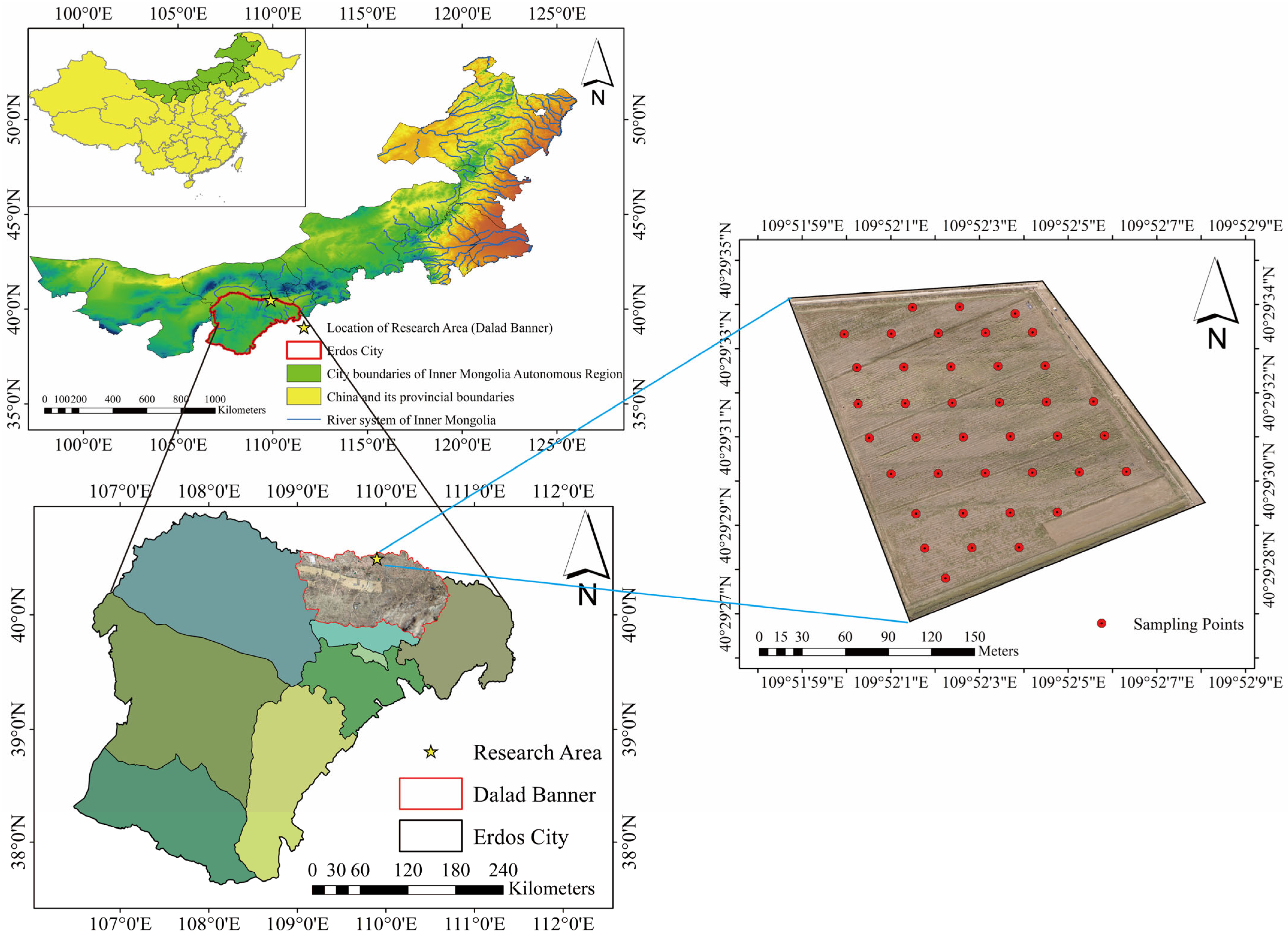
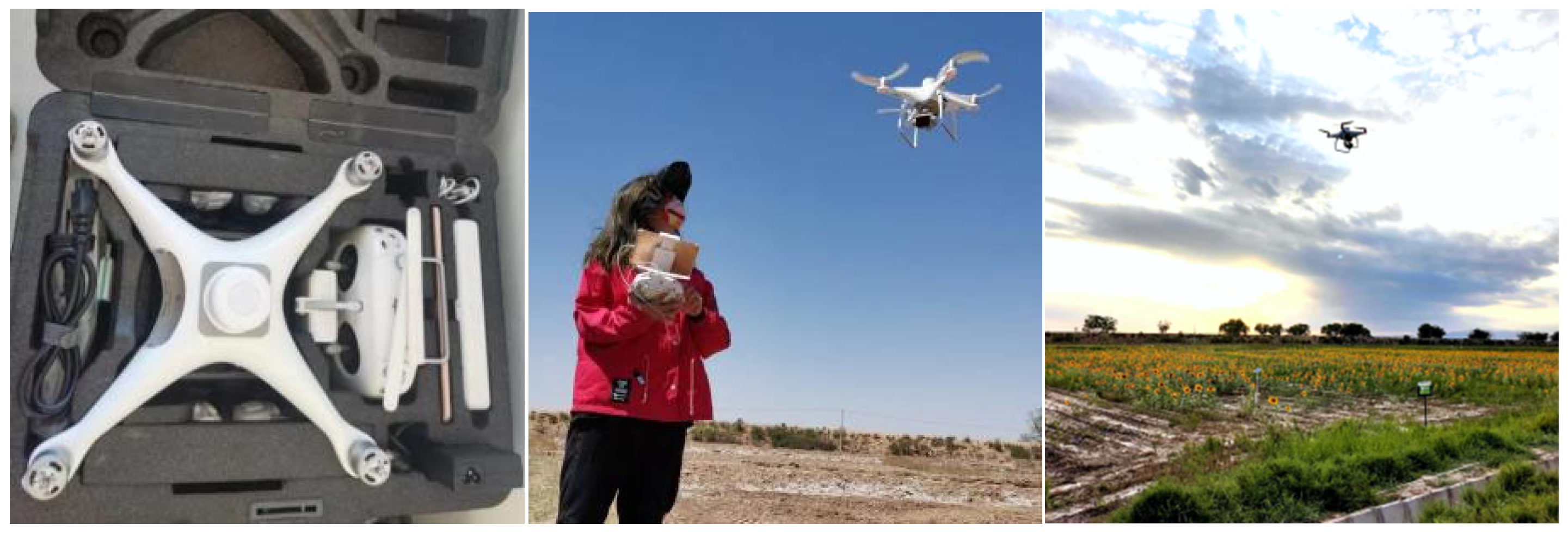
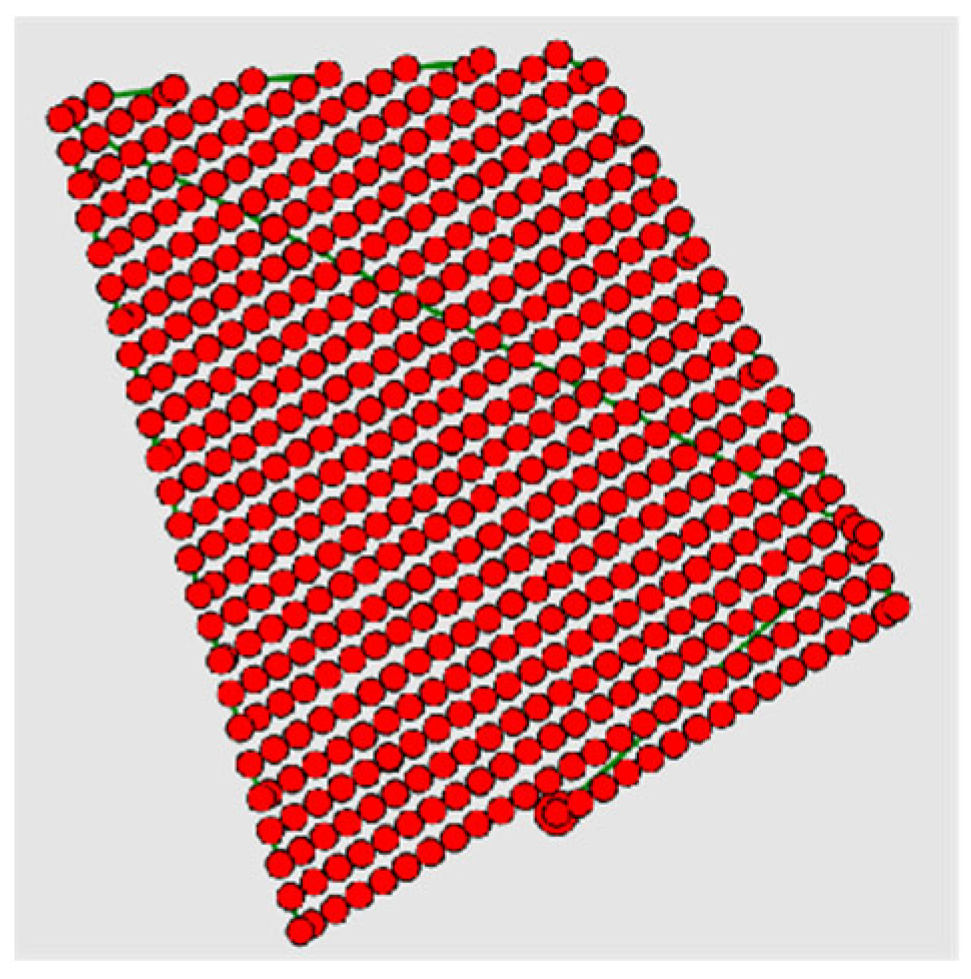



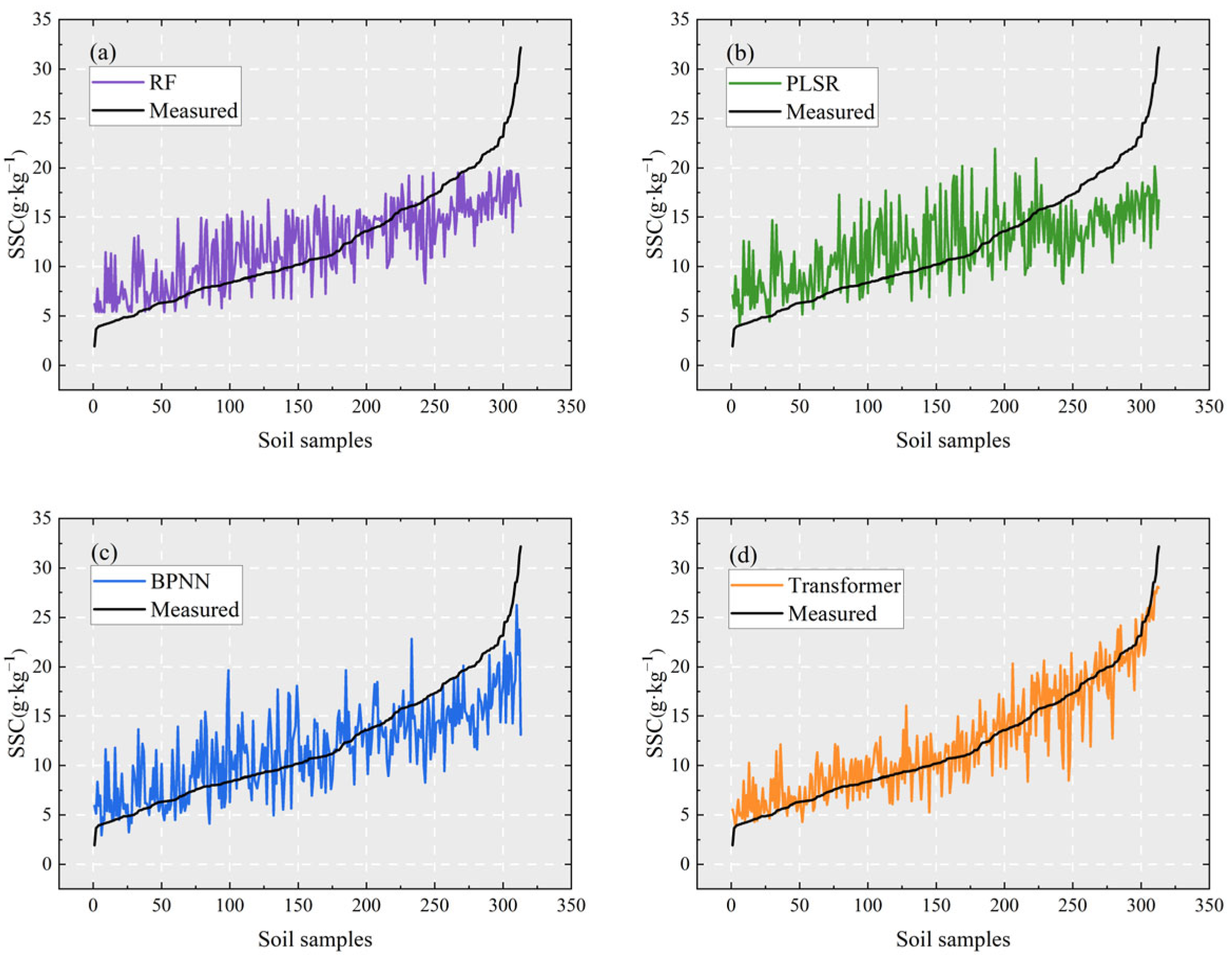
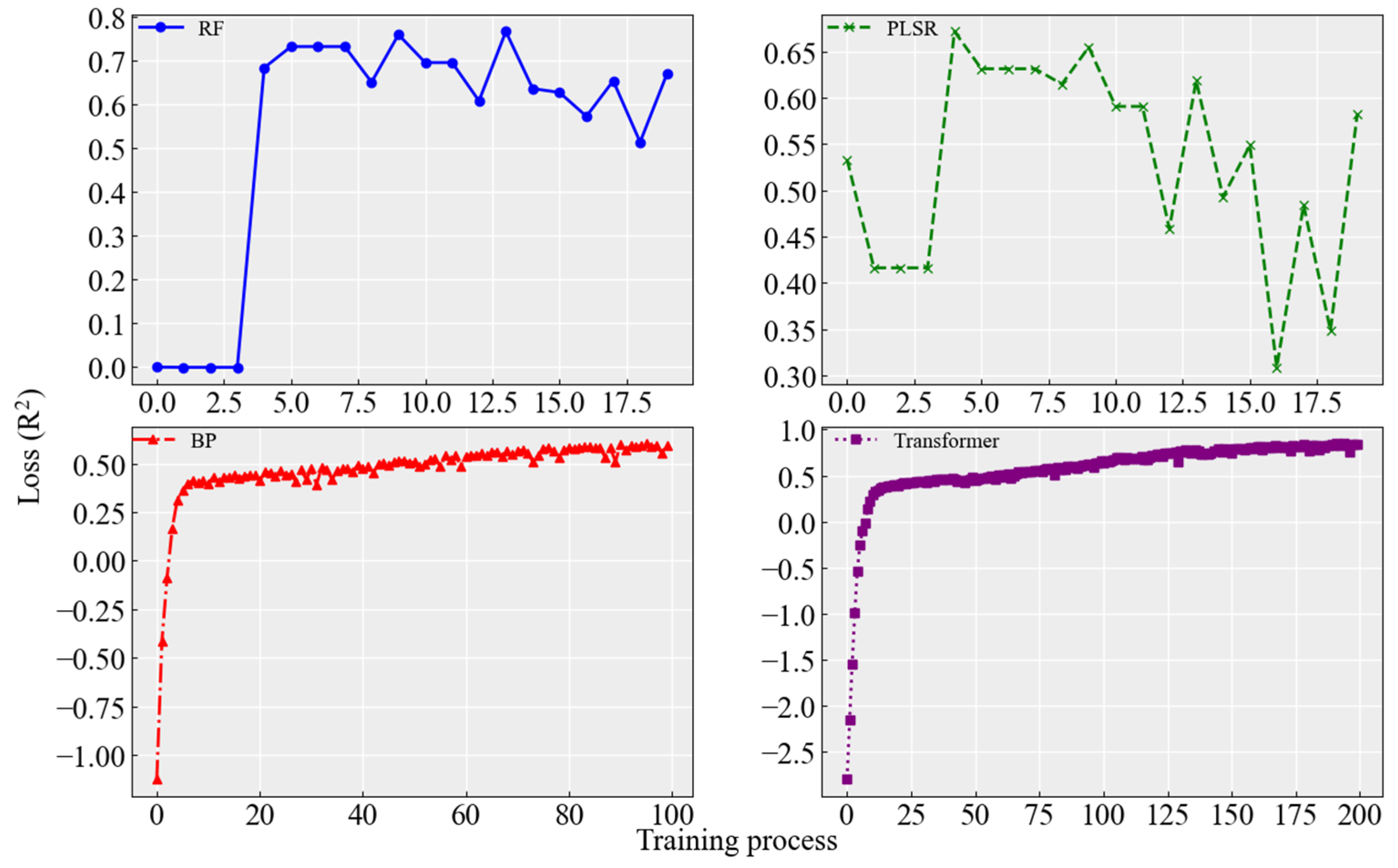
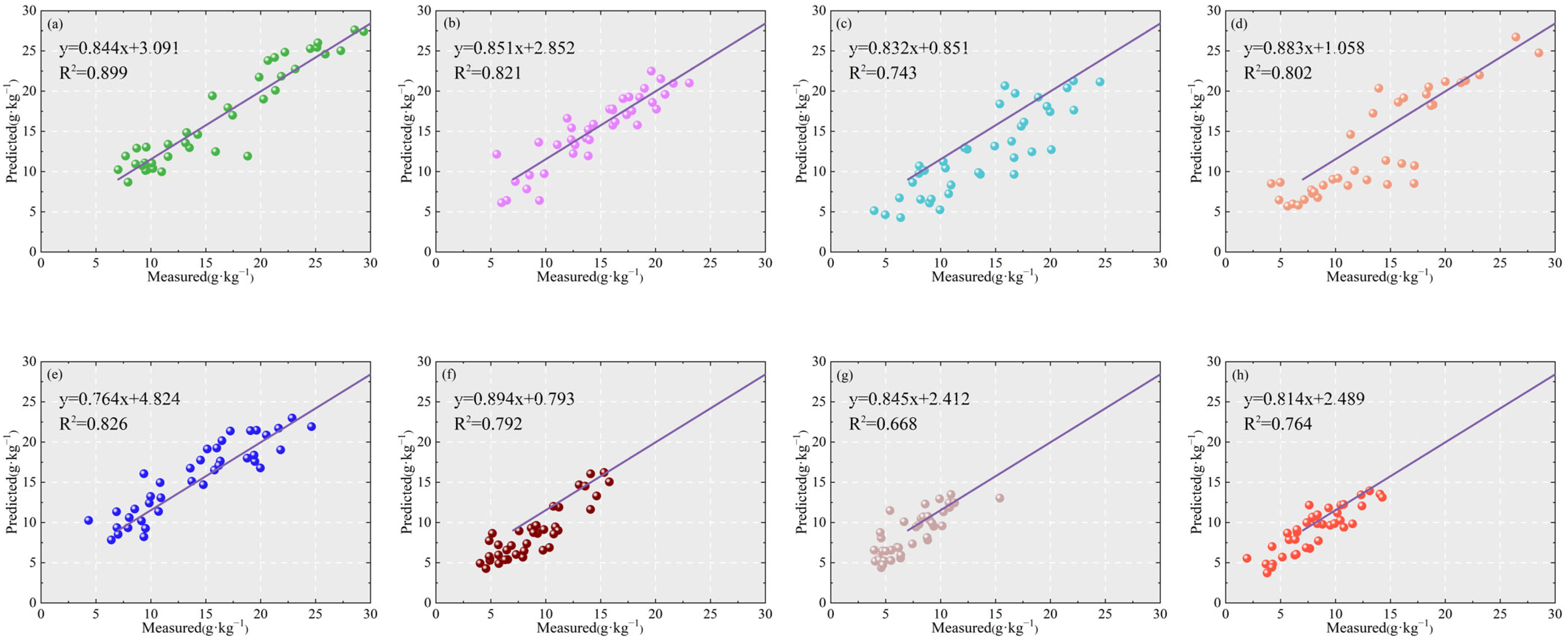
| Soil Depth (cm) | Saturation Moisture Content (%) | Field Capacity (%) | Bulk Density (g·cm−3) | Soil Texture |
|---|---|---|---|---|
| 0–20 | 32.12–35.06 | 28.69–33.37 | 1.43–1.46 | Silt |
| 20–40 | 35.77–38.24 | 31.84–35.67 | 1.37–1.39 | Silt loam |
| 40–60 | 33.25–38.31 | 32.01–34.02 | 1.36–1.40 | Silt loam |
| 60–80 | 27.01–31.85 | 26.33–29.62 | 1.43–1.46 | Silt loam |
| 80–100 | 30.45–34.16 | 28.21–32.34 | 1.41–1.44 | Silt loam |
| Spectral Index | Calculation Formula | Spectral Index | Calculation Formula |
|---|---|---|---|
| S2 | S2 = (B − R)/(B + R) | DVI | DVI = NIR − R |
| S3 | S3 = (R × G)/B | RVI | RVI = NIR/R |
| S4 | S4 = (B × R)0.5 | SI* | SI* = (RE + R)0.5 |
| S5 | S5 = (B × R)/G | SI1* | SI1* = (RE × R)0.5 |
| S6 | S6 = (R × NIR)/G | SI2* | SI2* = (G2 + R2 + RE2)0.5 |
| SI1 | SI1 = (G × R)0.5 | SI3* | SI3* = (RE2 + R2)0.5 |
| SI2 | SI2 = (G2 + R2 + NIR2)0.5 | Int1* | Int1* = (RE + R)/2 |
| SI3 | SI3 = (G2 + R2)0.5 | Int2* | Int2* = (G + R + RE)/2 |
| SI | SI = (B + R)0.5 | SI-reg | SI-reg = (B + RE)0.5 |
| SRSI | SRSI = ((NDVI − 1)2 + SI12)0.5 | SI1-reg | SI1-reg = (G × RE)0.5 |
| BI | BI = (R2 + NIR2)0.5 | SI2-reg | SI2-reg= (G2 + RE2 + NIR2)0.5 |
| Int1 | Int1 = (G + R)/2 | SI3-reg | SI3-reg = (G2 + RE2)0.5 |
| NDVI | NDVI = (NIR − R)/(NIR + R) | Int1-reg | Int1-reg = (G+ RE)/2 |
| VIopt | VIopt = 1.45 × ((NIR2 + 1)/(R + 0.45)) | Int2-reg | Int2-reg = (G + RE + NIR)/2 |
| Time | Number of Samples | SSC (g/kg) | |||||||||||
|---|---|---|---|---|---|---|---|---|---|---|---|---|---|
| Total Sample | Nonsaline Soil | Light Saline Soil | Moderately Saline Soil | Heavy Saline Soil | Saline Soil | Max | Min | Avg. | SD | Med. | CV | ||
| 2022 | Before spring irrigation | 40 | 0 | 0 | 0 | 15 | 25 | 32.2 | 7.0 | 16.7 | 7.1 | 15.8 | 0.426 |
| Budding stage | 39 | 0 | 0 | 3 | 7 | 29 | 23.1 | 5.5 | 14.5 | 4.7 | 14.3 | 0.325 | |
| Flowering stage | 39 | 0 | 2 | 2 | 13 | 22 | 24.5 | 4.0 | 13.5 | 5.4 | 13.4 | 0.401 | |
| Maturity stage | 39 | 0 | 3 | 3 | 12 | 21 | 31.3 | 4.2 | 13.9 | 6.8 | 13.4 | 0.492 | |
| 2023 | Before spring irrigation | 39 | 0 | 1 | 3 | 13 | 22 | 24.6 | 4.3 | 13.9 | 5.4 | 14.5 | 0.389 |
| Budding stage | 39 | 0 | 6 | 8 | 18 | 7 | 15.8 | 4.0 | 8.9 | 3.3 | 8.7 | 0.375 | |
| Flowering stage | 39 | 0 | 10 | 9 | 19 | 1 | 15.4 | 4.0 | 7.4 | 2.6 | 7.4 | 0.355 | |
| Maturity stage | 39 | 1 | 6 | 8 | 19 | 5 | 14.3 | 1.9 | 8.1 | 3.1 | 7.9 | 0.381 | |
| Evaluation Index | RF | BPNN | PLSR | Transformer | ||||
|---|---|---|---|---|---|---|---|---|
| Train | Test | Train | Test | Train | Test | Train | Test | |
| RMSE | 3.96 | 3.68 | 3.98 | 3.98 | 4.72 | 4.10 | 2.22 | 2.41 |
| R2 | 0.56 | 0.54 | 0.56 | 0.46 | 0.56 | 0.43 | 0.83 | 0.84 |
| MAE | 3.04 | 2.88 | 3.00 | 3.08 | 3.72 | 3.26 | 1.67 | 1.84 |
| MRE | 0.29 | 0.27 | 0.28 | 0.30 | 0.60 | 0.52 | 0.17 | 0.17 |
| MBE | 3.04 | 2.88 | 3.00 | 3.08 | 5.63 | 5.14 | 1.67 | 1.67 |
Disclaimer/Publisher’s Note: The statements, opinions and data contained in all publications are solely those of the individual author(s) and contributor(s) and not of MDPI and/or the editor(s). MDPI and/or the editor(s) disclaim responsibility for any injury to people or property resulting from any ideas, methods, instructions or products referred to in the content. |
© 2024 by the authors. Licensee MDPI, Basel, Switzerland. This article is an open access article distributed under the terms and conditions of the Creative Commons Attribution (CC BY) license (https://creativecommons.org/licenses/by/4.0/).
Share and Cite
Wang, Y.; Qu, Z.; Yang, W.; Chen, X.; Qiao, T. Inversion of Soil Salinity in the Irrigated Region along the Southern Bank of the Yellow River Using UAV Multispectral Remote Sensing. Agronomy 2024, 14, 523. https://doi.org/10.3390/agronomy14030523
Wang Y, Qu Z, Yang W, Chen X, Qiao T. Inversion of Soil Salinity in the Irrigated Region along the Southern Bank of the Yellow River Using UAV Multispectral Remote Sensing. Agronomy. 2024; 14(3):523. https://doi.org/10.3390/agronomy14030523
Chicago/Turabian StyleWang, Yuxuan, Zhongyi Qu, Wei Yang, Xi Chen, and Tian Qiao. 2024. "Inversion of Soil Salinity in the Irrigated Region along the Southern Bank of the Yellow River Using UAV Multispectral Remote Sensing" Agronomy 14, no. 3: 523. https://doi.org/10.3390/agronomy14030523
APA StyleWang, Y., Qu, Z., Yang, W., Chen, X., & Qiao, T. (2024). Inversion of Soil Salinity in the Irrigated Region along the Southern Bank of the Yellow River Using UAV Multispectral Remote Sensing. Agronomy, 14(3), 523. https://doi.org/10.3390/agronomy14030523





